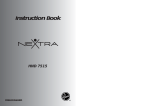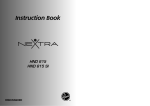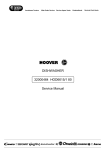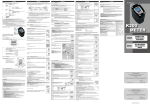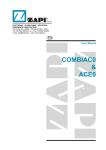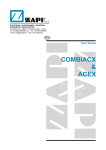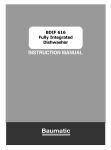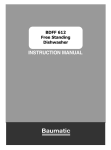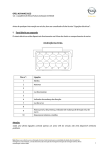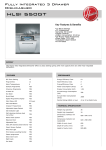Download Instruction Manual
Transcript
DISHWASHER BI
32900494 HLSI 762GTWIFI-8
Service Manual
32900494 HLSI 762GTWIFI-8 9953(31/12/2099)
Ref
4a
4b
8a
8c
14g
14y
21
27
28
29
44
54a
55
69
85c
85d
92
92a
93
100
103
117
122
126
127
134
135a
138
138a
138b
139
141
142a
148a
149
150
151a
151b
151e
151i
151z
153
157
157k
161
161a
164
171
172
173
Description
Right basket guide
Left basket guide
Foot
Rear adjustable foot
ON-OFF push button
Keyboard for Module
Control panel assy
Closure regulator
Catch
Screw
Door lock
Innerdoor lower gasket
Front gasket
Insulating panel
R/H hinge assy
L/H hinge assy
Innerdoor
Innerdoor screw
Door
Electrodistributor
Gasket
Nozzle
Gasket
Seal gasket
Metal ring
Electrovalve
Hose
Drain hose
Drain house elbow
Hoseb clamp
Hose clamp D.15
Rubber washer
Fill hose red
Outer heater assy
WI-FI Option Board
Door micro switch
Electronic module
Electr.plate box
Touch controls/display board
Electronic plate cover
Not programmed Electronic module
Level switch
Wiring harness
8 Way connecton
Drain pump
Drain pump scroll
Anti jamming filter radio
Motor pump
Clip
Hose
Code
41017657
41017656
41026789
91670150
41002304
41030891
41902263
91800770
41014449
41013184
41013195
91620003
41019164
41017649
41026939
41026940
41010279
91401201
41900042
41900461
49004681
92694801
41029495
41029550
41029551
41033495
91620008
91670102
92689587
91600328
92470012
92485226
41900781
41006831
41901840
41009693
49033115
41012372
41028853
41012373
41901604
41030820
41902306
41029046
91200173
91600290
41038124
41900804
91408000
91620007
Begin
End
Ref
177
200
204a
204b
205
208
208a
209
217
218
225a
241
243
243b
243c
244
244a
244b
244c
244d
245
246
249a
249b
250
251
257
257a
257b
258a
258b
258c
258d
272
275
283a
287m
290
295a
295b
296
297
299
305
305b
311
311a
313
314
315
Description
Motor Schoch absorber
Drawer grasket
Upper spray arm
Lower spray arm
Spray arms tube
Filter
Microfilter
Filter plate
Filter bacin.
OR seal gasket
Gasket
Lower basket wheel
Lower basket
Inclinable plates holder
Inclinable small plates holder
Upper basket
Plates holder
Basket regulation assy L/H
Basket regulation assy R/H
Grip
Basket wheel pin
Basket wheel upper.
R/H front-L/H rear cups basket
L/H front-R/H rear cups basket
Wheel stopper
Runner
Cutlery basket
Insert
Cutlery holder
Basket rear handle
Basket front handle
Post. handle inferior basket
Front handle inferior basket
Clip
Level hose
Hub
NTC probe
Bearing for spray arm
Water softener
Water softener OR seal gasket
Water softener stopper
Hose
Water softener capacitor
Spring
Door balance assy
Sleeve
Sleeve
Funnel
Slider
Spring
Code
92131762
91406300
41009782
41009781
41900782
41005927
41014367
91800738
41026774
91406302
92445626
91601253
41022916
41022779
41015096
41900786
41011632
41900796
41900795
41011412
91601247
91601248
41023030
41023031
91619627
91800137
41901707
41900582
41900742
41900557
41900556
41900559
41900558
92470244
41026801
41009859
41022107
91405300
41026897
91941698
41029552
91620010
41026799
41901365
41015822
91602981
41010216
91601457
91600272
92484021
Begin
End
Ref
316
318
321a
321b
321c
321d
322
323
329c
330
332
333
352a
362
364
377
377a
395
399
402
403
408a
408b
454
474
474a
491c
493
498
618c
797
798
799
824
824a
839
999
Description
Center square
Upper ramp tube
Deviator
Deviator valve
Deviator valve holder
Non return valve
Seal
Seal
Cover
Subseq.runner ass.support
Botton cover
Water softener reed
Upper condensation protection
Wheel support reinforc.
Upper basket stopper
Center square
Upper center square
Air break ring nut
Built-in envelope assy
Harness protection
Fixing cable
R/H later.panel
L/H later.panel
Ribbon
Safety switch
Gasket safety switch
Mains cable x UK
Upper cover
Hose
Unipolar NA+P.A. switch
Hook
Clutch body
Clutching band
Pin
Rod
Clip
Electrical diagram
Code
91600271
41009353
41009202
91600267
41009257
91941700
91406301
41009258
41027071
91670988
41030370
49016819
41035692
91602344
91601047
91621961
41024985
41029447
41900626
41033546
41901113
41900043
41900044
92546183
41901973
41009096
91200213
41017653
41027168
90489683
92734912
41026792
92895838
91600493
91600495
92470277
41901844
Begin
End
TUBI DI CARICO E SCARICO ACQUA DI LUNGHEZZA
MAGGIORATA PER LAVASTOVIGLIE PRODOTTE DAL 1999
SU TUTTI I MODELLI A PARTIRE DALLA GAMMA LS99 E’ POSSIBILE SOSTITUIRE IL TUBO DI
CARICO E SCARICO ORIGINALI CON ANALOGHI DI LUNGHEZZA PARI A 2.5 METRI.
92250141
PROLUNGA PER TUBO DI CARICO (SENZA SICUREZZA)
49022188
TUBO DI CARICO (SENZA SICUREZZA)
41007951
TUBO DI CARICO CON PROTEZIONE TRASPARENTE
91941797
TUBO DI CARICO PER MODELLI DOTATI DI “WATER CONTROL”
(SISTEMA DI SICUREZZA ANTI ALLAGAMANTO SOLO SUL TUBO).
91941798
TUBO DI CARICO PER MODELLI DOTATI DI “WATER BLOCK” (SISTEMA
DI SICUREZZA ANTI ALLAGAMENTO TOTALE
CON DOPPIA
ELETTROVALVOLA SUL TUBO) E DI CONTALITRI.
91942179
TUBO DI CARICO PER MODELLI DOTATI DI “WATER BLOCK” (SISTEMA
DI SICUREZZA ANTI ALLAGAMENTO TOTALE
CON DOPPIA
ELETTROVALVOLA SUL TUBO) SENZA CONTALITRI.
41011986
TUBO DI SCARICO SPIRALATO
EXTENDED LENGHT WATER FILL HOSES AND DRAIN HOSES
SUITABLE FOR DISHWASHERS FROM THE 1999 RANGE ONWARD
ON ALL MODELS OF DISHWASHER, FROM THE RANGE 1999 ONWARD, IT'S POSSIBLE TO
REPLACE THE ORIGINAL WATER FILL HOSE WITH A SPARE ONE 2.5 METERS LONG.
92250141
EXTENSION FILL HOSE (WITHOUT ANY SAFETY DEVICE).
49022188
SIMPLE WATER FILL HOSE (WITHOUT ANY SAFETY DEVICE)
41007951
WATER FILL HOSE WITH TRANSPARENT PROTECTION
91941797
WATER FILL HOSE SUITABLE FOR APPLIANCES FITTED WITH "WATER
CONTROL" (ANTI-FLOOD SAFETY SYSTEM, PROTECTING THE ONLY
FILL HOSE).
91941798
WATER FILL HOSE SUITABLE FOR APPLIANCES FITTED WITH "WATER
BLOCK" (ANTI-FLOOD SAFETY SYSTEM WITH DOUBLE SOLENOID VALVE
ON THE SAME HOSE AND LITRES COUNTER).
91942179
WATER FILL HOSE SUITABLE FOR APPLIANCES FITTED WITH "WATER
BLOCK" (ANTI-FLOOD SAFETY SYSTEM WITH DOUBLE SOLENOID VALVE
ON THE SAME HOSE BUT WITHOUT LITRES COUNTER).
41011986
DRAIN HOSE IN PLASTIC
EN
User instructions
®
HLSI 762GT WIFI
DISHWASHER
CONTENTS
pag.
pag.
pag.
pag.
pag.
pag.
pag.
pag.
pag.
pag.
pag.
pag.
pag.
pag.
pag.
pag.
pag.
pag.
pag.
pag.
General safety rules
Water connection
Loading the salt
Adjusting the upper basket
Loading the dishes
Information for test laboratories
Loading the detergent
Types of detergent
Loading the rinse aid
Cleaning the filters
Some practical hints
Routine cleaning and maintenance
Description of the control panel
Technical data
Programme selection and special functions
Water softener unit
Programme guide
Wizard
Identifying minor faults
Your guarantee
4
7
9
10
11
13
14
15
16
17
18
19
20
20
21
25
26
28
30
32
Fig. A
5
1
4
2
3
Please read the instructions in this booklet carefully because they contain important
information on how to install, use and maintain your dishwasher safely as well as
containing useful tips on how to make the most of it.
Keep this booklet safe for future reference.
3
above and persons with reduced
physical, sensory or mental
capabilities or lack of experience
and knowledge if they have been
given supervision or instruction
concerning use of the appliance in
a safe way and understand the
hazards involved.
Children shall not play with the
appliance. Cleaning and user
maintenance shall not be made
by children without supervision.
GENERAL SAFETY RULES
■ This appliances is intended to be
used in household and similar
applications such as:
- staff kitchen areas in shops,
offices and other working
environments;
- farm houses;
- by clients in hotels, motels
and other residential type
environments;
- bed and breakfast
environments.
■ Children should be supervised to
ensure that they do not play with
the appliance.
type
■ Children of less than 3 years
should be kept away unless
continuously supervised.
A different use of this appliance
from household environment or
from
typical
housekeeping
functions, as commercial use by
expert or trained users, is
excluded even in the above
applications.
■ Should it be necessary to replace
the supply cord, call the After
Sales Service Centre.
■ The appliance must be connected
to the water mains using new
hose-sets. The old hose-sets
should not be reused.
If the appliance is used in a
manner inconsistent with this
it may reduce the life of the
appliance and may void the
manufacturer’s warranty.
■ Water pressure must be between
0,08 MPa and 0,8 MPa.
Any damage to the appliance or
other damage or loss arising
through use that is not consistent
with domestic or household use
(even if located in a domestic or
household environment) shall not
be accepted by the manufacturer
to the fullest extent permitted by
law.
■ This appliance can be used by
children aged from 8 years and
■ When the appliance is located on
a carpet floor, attention must be
paid to ensure that there is no
obstruction to the bottom vents.
4
■ After installation, the appliance
must be positioned so that the
plug is accessible.
■ In general it is not advisable to use
adaptors, multiple plugs and/or
extension cables.
■ For the maximum place loading,
please refer to the "TECHNICAL
DATA" table/section.
■ Do not remove the plug from the
mains supply socket by pulling the
mains cable or the machine itself.
WARNING !
Knives and other utensils with
sharp points must be loaded
in the basket with their points
down or placed in a horizontal
position.
■ Do not leave the appliance exposed to the elements (rain, sun etc).
■ Leaning or sitting on the open
door of the dishwasher could
cause it to tip over.
■ The door should not be left in the
open position since this could present a potential hazard ( es. tripping ).
■ The dishwasher is designed for
normal kitchen utensils.
Objects that have been contamined by petrol, paint, traces of steel
or iron, corrosive chemicals, acids
or alkalis must not be washed in
the dishwasher.
■ To consult the product fiche please refer to the manufacturer website.
■ If there is a water softening device
installed in the home there is no
need to add salt to the water softener fitted in the dishwasher.
Safety instructions
■ Make sure the electrical system
is grounded. Otherwise, seek
qualified professional assistance.
■ If the appliance breaks down or
stops working properly, switch it
off, turn off the water supply and
do not tamper with it. Repair work
should only be carried out by an
approved service agent and only
genuine spare parts should be fitted. Any failure to follow the above
advice may have serious consequences for the safety of the
appliance.
Manufacturer declines all
responsibility for any damage
due to non-earthing of the
machine.
■ Ensure that the dishwasher does
not crush power cables.
5
■ If it you need to move the machine after removing the packaging,
do not try to lift it by the bottom of
the door.
Open the door slightly and lift the
machine by holding on the top.
Appliance complies
European Directives:
with
■ 2006/95/EC (LVD);
■ 2004/108/EC (EMC);
■ 2009/125/EC (ErP);
■ 2011/65/EU (RoHS)
and subsequent amendments
■ For the installation of built-in
appliances, please refer to the
specific chapter or to the instructions enclosed with the booklet.
6
WATER CONNECTION
IMPORTANT
The appliance must be connected to
the water mains using new hose-sets.
The old hose-sets should not be reused.
1
■ The inlet and drain hoses can be directed
to left or right.
IMPORTANT
The dishwasher can be connected to
either cold or hot water, as long as it
is no hotter than 60°C.
■ Water pressure must be between
0,08 MPa and 0,8 MPa.
2
■ The inlet hose must be connected to a
tap so that the water supply can be cut
off when the machine is not in use
(fig. 1 B).
■ The dishwasher is fitted with 3/4" threaded
connector (fig. 2).
■ Connect inlet hose “A” to water tap “B”
with a 3/4" attachment making sure that
it has been properly tightened.
■ If it is necessary, the inlet pipe can be
lengthened up to 2,5 m. The extension
pipe is available from the After Sales
Service Centre.
■ If the dishwasher is connected to new
pipes or to pipes which have not been in
use for a long time run water through for
a few minutes before connecting the
inlet hose. In this way no deposits of
sand or rust will clog up the water inflow
filter.
7
■ The hose can be hooked over the side of
the sink, but it must not be immersed in
water, in order to prevent water from
being syphoned back to the machine
when this is in operation (fig. 4Y).
Connecting the outlet hose
■ The outlet hose should disharge into a
standpipe, making sure that there are no
kinks (fig. 4).
■ When installing the appliance under a
worktop the hose pipe clamp must be
attached to the wall in the highest possible
position under the worktop (fig. 4Z).
■ The standpipe must be at least 40 cm
above floor level and it must have an
internal diameter of at least 4 cm.
■ Check that there are no kinks in the inlet
and outlet hoses.
■ It is advisable to fit an anti-odour air trap
(fig. 4X).
■ If necessary the outlet hose can be
extended up to 2,5 m, provided that it is
kept at a maximum height of 85 cm
above floor level. The extension pipe is
available from the After Sales Service
Centre.
4
8
■ The salt dispenser has a capacity of
between 1.5 and 1.8 kg and, for efficient
use of the appliance, it should be refilled
from time to time according to the
regulation of the water softener unit.
LOADING THE SALT
■ The appearance of white stains on dishes
is generally a warning sign that the salt
container needs filling.
■ On the bottom of the machine there is a
container for the salt for regenerating
the softener.
IMPORTANT
(Only for first start up)
When the appliance is used for the
first time, after completely filling the
salt container, it is necessary to add
water until the container overflows.
■ It is important to use only a salt that is
specifically designed for dishwasher.
Other types of salt contain small quantities
of insoluble particles which over a long
period of time may affect and deteriorate
the softener performance.
■ To add salt, unscrew the cap of the container on the bottom and then refill the
container.
■ During this operation a little water will
overflow; but keep adding salt until the
container is full. When the container is
full, clean the thread of salt residue and
retighten the tap.
■ After loading the salt, it is recommended
running a complete washing cycle,
or COLD RINSE programme. The salt
IMPORTANT
After loading the salt, YOU
MUST run a complete washing
cycle, or the PRE-WASH/COLD
RINSE/REFRESH programme.
9
ADJUSTMENT OF THE
UPPER BASKET
1
If 29 cm to 32,5 cm plates are normally
used, load them onto the lower basket after
the upper basket has been placed in its
upper position and proceed as detailed
below:
1. Pull out the upper basket;
2
2. Then grasp the basket from both sides
and lift it upwards (fig. 1).
a
b
a
Dishes that are bigger than 20 cm in
diameter can no longer be loaded onto the
upper basket and the mobile supports
cannot be used when the basket is in the
upper position.
b
ADJUST BASKET TO THE LOWER
POSITION:
3
1. Grasp the basket from both sides and lift
slightly upwards (fig. 2a);
2. Then slowly release into the correct
position (fig. 2b).
N. B. : NEVER LIFT OR LOWER THE
BASKET BY ONE SIDE ONLY (fig.3).
Attention :
it is advisable to adjust the basket before
loading the dishes.
10
A standard daily load is represented in
figs. 1, 2 and 3.
LOADING DISHES
Using the upper basket
Upper basket (fig. 1)
A = soup plates
B = dinner plates
C = dessert plates
D = saucers
E = cups
F = glasses
■ The upper basket is provided with
mobile racks hooked to the sides of the
basket, which can be regulated into 4
positions.
■ In the lowered position (A-A1) the racks
may be used for such items as: tea and
coffee cups, kitchen knives and ladles.
Also glasses with stems may be safely
hung on the ends of the racks.
A
1
A1
B
D
■ In the upright position (B-B1) the racks
allow you to load dinner plates and soup
plates. Plates should be loaded
vertically with the underside of the plate
towards the back of the dishwasher with
a space between each plate to allow
water to pass freely.
B
F
Upper basket (fig. 2)
A = soup plates
B = dinner plates
C = dessert plates
D = saucers
E = cups
F = glasses with stems
G = glass
H = cutlery basket
B1
■ It is advisable to load large plates
(approx. 26 or more cm) slightly tilted
towards the rear to facilitate introduction
of the basket into the machine.
2
B
A
■ Salad bowls and plastic bowls may also
be loaded on the upper basket. It is
advisable to block these in place so that
the jets of water do not make them
overturn.
■ The upper basket has been designed to
offer maximum flexibility in use and can
be loaded with up to 24 plates on two
rows, up to 30 glasses on five rows or a
mixed load.
E
C
A
H
11
C
D F
E
F
G
- POSITION “B”: for dishes which,
although standard size, have a particular
shape (very deep bowls, square dishes
or ones without borders etc.).
Upper basket (fig. 3)
A = glasses
B = saucers
C = cups
D = small bowl
E = medium bowl
F = large bowl
G = dessert plate
H = serving spoons
I = ladle
L = cutlery
3
- POSITION “C”: for larger than average
flat plates and/or ones with nonstandard shapes (square, hexagonal,
oval, pizza dishes etc.).
4
I
L
F
C
B
A
G
C D
E
C
5
B
C
A
H
A
H
■ The small plates, as those used for
desserts for example, must be placed in
the lower basket as shown in the figure 6,
with the support flap placed outwards ("B").
For normal or large plates the flap must
be in the position ("A").
Using the lower basket
■ Saucepans, oven dishes, tureens, salad
bowls, lids, serving dishes, dinner
plates, soup plates and ladles can be
loaded on the lower basket.
6
■ Place the cutlery in the plastic cutlery
holder with the handles pointing
upwards.
■ Place the cutlery holder on the lower
basket (fig. 7 and 8), making sure that
the cutlery does not get in the way of the
rotating arms.
A
■ The lower basket is fitted with a special
adjustable central rack (fig. 4 and 5).
This permits stable and optimum
loading, even when the size and/or
shape of the dishes is non-standard.
B
WARNING!
If the small plates are placed in the
basket with the support flap in the
incorrect position, the plates will
interfere with the lower spraying arm
preventing it to rotate.
- POSITION “A”: for a standard load, or
one that excludes pans, salad bowls and
the like.
12
Please load the dishwasher sensibly to
ensure the best wash results.
A standard daily load is represented in
figs. 7 and 8.
Lower basket (fig. 7)
A = medium-sized saucepan
B = large saucepan
C = frying pan
D = tureens, serving dishes
E = cutlery
F = oven dishes
G = medium bowl
H = small bowl
IMPORTANT
The lower basket has a safety-stop
device, for its safe extraction, also
especially useful with a full load.
For loading salt, cleaning filter and for
ordinary maintenance, the complete
extraction of the basket is necessary.
7
B
A
F
INFORMATION FOR THE TEST
LABORATORIES
C
G
D
E
H
Please ask information required for
comparison testing and measuring noise
levels, according to EN normative, to the
following address:
[email protected]
In the request, please specify model name
and number of the dishwasher (see rating
plate).
Lower basket (fig. 8)
A = soup plates
B = dinner plates
C = dessert plates
D = serving dish
E = cutlery
8
D
B
A
C
C
E
13
LOADING THE DETERGENT
The detergent
IMPORTANT
It is essential to use a detergent
that is specifically designed for
dishwashers either in powder, liquid
or tablet form.
B
After pouring the detergent into the container,
close the lid, firstly pushing (1) and then
pressing on it (2) until you hear the click.
“FINISH” gives very good results and can
be easily obtained.
Unsuitable detergents (like those for
washing up by hand) do not contain the
proper ingredients for use in a dishwasher,
and stop the dishwasher from working
correctly.
Filling the detergent container
The detergent container is inside the door
(fig. A “2”). If the lid of the container is
closed, press the button (A) to open.
At the end of every wash cycle the lid is
always open and ready for the next time
the dishwasher is used.
Since not all detergents are the same the
instructions on the boxes of detergent can
vary. We should just like to remind users
that too little detergent does not clean the
dishes properly whilst too much detergent
will not produce better results and is also a
waste.
WARNING!
When loading the lower basket, please
ensure that the plates or others do not
obstruct the detergent dispenser.
The amount of detergent to be used varies
according to how dirty the dishes are and
on the type of dishes to be washed.
We advise using 20÷30 g of detergent in the
wash section of detergent compartment (B).
IMPORTANT
Do not use an excessive amount of
detergent and help limit damage to
the environment at the same time.
A
14
■ the effectiveness of detergents containing
the built in water softener/salt depends
on the hardness of your water supply.
Check that the hardness of your water
supply is within the effective range given
on the detergent packaging.
TYPES OF DETERGENT
Detergent tablets
Detergent tablets of different manufacturers
dissolve at different speeds, for this
reason, during short programmes, some
detergent tablets may be not fully effective,
because they are not completely dissolved.
If these products are used, is recommended
to choose longer programmes to guarantee
the complete use of the detergent.
If when using this type of product, you
don't get satisfactory washing results,
please
contact
the
detergent
manufacturer.
In certain circumstances use of combined
detergents can cause:
IMPORTANT
To get satisfactory washing results,
the tablets MUST be placed in the
wash section of the detergent
container and NOT directly in the
tub.
■ limescale deposits on dishes or in the
dishwasher;
■ a reduction in washing and drying
performance.
Concentrated detergents
IMPORTANT
Any problems which arise as a direct
result of the use of these products
are not covered by our warranty.
The concentrated detergents, with reduced
alkalinity and with natural enzymes, in
conjunction with 50°C wash programmes,
have a smaller impact on the environment
and they protect the dishes and the
dishwasher.
The 50°C wash programmes purposely
exploit the dirt-dissolving properties of the
enzymes, allowing therefore, with the use
of the concentrated detergents, to achieve
the same results of the 65°C programmes
but at a lower temperature.
Please note that using the "ALL in 1"
combined detergents, the rinse aid and
salt indicator lights (only used on
selected models) are superfluous, so you
must ignore the lights.
Combined detergents
If washing and/or drying problems occur,
we recommend you return to use traditional
separate products (salt, detergent and
rinse agent). This will ensure that the water
softener in the dishwasher operates
correctly.
The detergents that also contain the rinse
aid must be placed in the wash section of
the detergent container. The rinse aid
container must be empty (if it is not empty,
set the rinse aid regulator to lowest position
before using combined detergents).
In this case, we recommends that you:
■ refill both the salt and rinse aid container;
"ALL in 1" combined detergents
■ run one normal washing cycle without a
load.
If you are planning to use “ALL in 1” (“3 in 1 “/
“4 in 1”/ “5 in 1”, etc.) combined detergents i.e.
those with built in salt and/or rinse agent,
we would advise the following:
Please note that on return to the use of
conventional salt, a number of cycles will
be required before the system becomes
fully efficient again.
■ read carefully and follow the manufacturer’s
instructions given on the packaging;
15
LOADING THE RINSE AID
The rinse aid
The rinse aid, which is automatically
released during the last rinsing cycle, helps
the dishes to dry quickly and prevents
spots and stains forming.
Filling the rinse aid container
C
The rinse aid container can be found to the
left of the detergent container (fig. A "3").
To open the lid, push the reference mark
and, in the same time, pull the tab of
opening.
It is always advisable to use rinse aid that
is specifically designed for dishwasher.
Check the rinse aid level through the
indicator eye (C) which is located on the
dispenser.
FULL
EMPTY
dark
light
Regulating the rinse aid from 1 to 6
The regulator (D) is placed under the lid
and can be turned using a coin.
The recommended position is 4.
The limestone content of the water
considerably affects the formation of
limescale and the drying performance.
It is therefore important to regulate the
quantity of rinse aid to achieve good
washing results.
If, after the wash, streaks occur on the
dishes, decrease the amount by one
position. If whitish spots occur, increase the
amount by one position.
D
16
CLEANING THE FILTERS
The filter system (fig.A “4”) consists of:
1
a central container that traps the larger
particles;
a flat gauze that continuously filters the
wash water;
a micro filter, located beneath the gauze,
that traps the tiniest particles ensuring a
perfect rinse.
■ To achieve excellent results every time,
the filters should be checked and
cleaned after each wash.
■ To remove the filter unit, simply turn the
handle anticlockwise (fig. 1).
2
■ For ease of cleaning, the central container
is removable (fig. 2).
■ Remove the gauze filter (fig.3) and
wash the whole unit under a jet of
water. If necessary a small brush can
be used.
■ With the Self-cleaning Micro filter,
maintenance is reduced and the filter
unit need only be checked every two
weeks. Nevertheless, after each wash it
is advisable to check that the central
container and the gauze filter are not
clogged.
WARNING!
After cleaning the filters, make sure
that they are correctly reassembled
and that the gauze filter is properly
positioned at the bottom of the
dishwasher.
3
Make sure that the filter is screwed
back, clockwise, into the gauze, as
poor seating of the filter unit could
have an adverse effect on the
efficiency of the appliance.
IMPORTANT
Never use the dishwasher without
the filters.
17
PRATICAL HINTS
How to make savings
■ If you want the dishwasher to give a
complete wash, place the dishes in the
dishwasher at the end of each meal and
if necessary turn on the COLD RINSE
cycle to soften the food remains and
remove bigger particles of food from the
new load of dishes.
When the dishwasher is full start the
complete wash cycle programme.
How to get really good wash
results
■ Before placing the dishes in the
dishwasher, remove any remaining
food (bones, shells, pieces of meat or
vegetables, coffee grounds, skin of fruit,
cigarette ash, tooth picks etc. to avoid
blocking the filters, water outlet and
washing arm nozzles.
■ If the dishes are not very dirty or if the
baskets are not very full select an
ECONOMY programme, following the
instructions in the program list.
■ Try not to rinse the dishes before
loading them into the dishwasher.
■ If saucepans and oven dishes are
encrusted with the remains of burnt or
roast food, it is advisable to leave them
to soak before washing.
What not to wash
■ It should be remembered that not all
dishes are suitable for washing in a
dishwasher.We advise against using
the dishwasher to wash items in
thermoplastic, cutlery with wooden or
plastic handles, saucepans with
wooden handles, items in aluminium,
crystal, leaded glass unless otherwise
stated.
■ Place the dishes face downwards.
■ Try to place the dishes in such a way
that they are not touching one another.
If they are loaded properly you will get
better results.
■ After loading the dishes check that the
washing arms can rotate freely.
■ Certain decorations may fade. It is
therefore a good idea before loading the
whole batch to wash just one of the
items first so as to be sure that others
like it will not fade.
■ Pans and other dishes that have
particularly stubborn food particles or
remnants of burnt food should be left to
soak in water with dishwasher
detergent.
■ It is a good idea not to put silver cutlery
with non-stainless steel handles into
the dishwasher as there could be a
chemical reaction between them.
■ To wash silver properly:
a) rinse the silver immediately after
use, especially if it has been used for
mayonnaise, eggs, fish etc.;
IMPORTANT
When buying new crockery or
cutlery always make sure that they are
suitable for washing in a dishwasher.
b) do not sprinkle detergent onto it;
c) keep it separate from other metals.
Useful hints
■ In order to avoid any dripping from the
top rack, remove the lower rack first.
■ If the dishes are to be left in the
machine for some time, leave the door
ajar, to let some air circulate and to
improve the drying performance.
18
CLEANING AND
MAINTENANCE
1
1b
■ To clean the dishwasher outside, do not
use solvents (degreasing action) neither
abrasives, but only a cloth soaked with
water.
■ The dishwasher does not require special
maintenance, because the tank is
self-cleaning.
■ Regularly wipe the door gasket with a
damp cloth to remove any food remains
or rinse aid.
2
■ Dishwasher cleaning is recommended,
in order to remove limestone deposits or
dirt. We suggest you run a washing cycle
periodically with specialist dishwasher
cleaning products. For all cleaning
operations the dishwasher must be
empty.
■ If, in spite of the routine cleaning of the
filters, you notice that the dishes or pans
are not properly washed or rinsed, check
that all the spray heads on the rotor
arms (fig. A “5”) are clear.
WHEN CYCLE IS FINISHED
If they are blocked, clean them in the
following way:
After every wash it is essential to turn off
water supply and to switch off the machine
by pressing the On/Off button to the off
position.
1. to remove the upper rotor arm, turn it
until it lines up with the stop marked
by the arrow (fig. 1b). Push it upwards
(fig. 1) and, keeping it pushed in,
unscrew it in a clockwise direction
(to reassemble it repeat the same
operation, but turn it anticlockwise).
The lower rotor arm can be removed
simply by pulling it upwards (fig. 2);
If the machine is not going to be used for
some time, it is advisable to follow these
rules:
1. do an empty wash with detergent in order
to clean the machine of any deposits;
2. wash the rotor arms under a jet of water
to clear any blockage in the spray
heads;
2. pull out the electric plug;
3. when you have finished, refit the rotor
arms in the same position, remembering
to re-align the arrow and screw into
position.
4. fill the rinse aid container;
3. turn off the water tap;
5. Ieave the door ajar;
■ Both the door lining and the tank lining
are in stainless steel; however, should
spots caused by oxidation occur, this is
probably due to a high level of iron salts
presents in the water.
■ The spots can be removed with a mild
abrasive agent; never use chlorine
based materials, steel wool, etc.
6. keep the inside of the machine clean;
7. If the machine is left in places where the
temperature is below 0°C any water left
inside the pipes may freeze. Wait until
the temperature rises above zero and
then wait for about 24 hours before
starting up the dishwasher.
19
DESCRIPTION OF THE CONTROL PANEL
A
GH I
L
P B C D E FM
O
N
A
B
C
D
E
F
DIGITAL DISPLAY
G
"DELAY START" indicator light
"PROGRAMME SELECTION" button
"DELAY START" button
"ALL in 1" option button
"ACTION PRO" buttons
"START"/"RESET" button
(start/cancelling programme)
H
I
L
M
N
O
P
"OPTION SELECTION" light
"ACTION PRO" lights
"SALT EMPTY" light
"RINSE AID EMPTY" light
Programme guide
"ON/OFF" button
Wi-Fi light (
)
DIMENSIONS
59,8 x 81,8 ÷ 89,8 x 55
117
Width x Height x Depth (cm)
Depth with door open (cm)
TECHNICAL DATA
16
9 persons
Min. 0,08 - Max. 0,8
EN 50242 place load
Capacity with pans and dishes
Water supply pressure (MPa)
See rating plate
Fuse / Power input / Supply voltage
CONSUMPTION (main programmes)*
Programme
Energy (kWh)
Water (L)
2,07
21
STEAM
1,53
15
UNIVERSAL
1,08
10
ECO
0,59
9
RAPID 24'
Power consumption of the off-mode and of the left-on mode: 0,30 W / 0,45 W
*Values are measured in a laboratory according to European Standard EN 50242 (consumption may
vary according to conditions of usage).
20
■ If you wish, press the option button (the
corresponding indicator light will turn on).
PROGRAMME SELECTION
AND SPECIAL FUNCTIONS
The option button can be selected or
deselected WITHIN one minute of the
programme commencing.
(Use in conjunction with programme guide)
■ Press the "START" button.
The length of the program will be shown on
the display alternating hours with minutes
[I.e.: 1 h (1 hour) / 25 (25 minutes)].
"ACTION PRO" button
This button allows you to modify the wash
intensity, according to how dirty your dishes
are, by modifying the wash time and
temperature.
Press the button to increase the intensity of
wash cycle (
indicator light) or to reduce
the intensity of wash, this also allows you to
decrease the wash length time (
indicator
light).
The combination of the button with the 4
main wash programmes enables to have 8
additional wash cycles (achieving a total of
12 programmes of washing).
■ Close the door (after an audible signal
has sounded, the programme will start
automatically).
WHITIN one minute of the programme
commencing, another programme
can be selected, by pressing the
"PROGRAMME SELECTION" button
(it is also possible to select or deselect
the "ACTION PRO" buttons).
IMPORTANT
When the dishwasher is switched on,
the setting last used will be indicated.
Programme settings
"IMPULSE" programmes
The “IMPULSE” programmes use an
impluse washing technology, which reduces
consumption, noise and increases
performances.
■ Open the door and place the dirty dishes
inside the appliance.
■ Press the "ON/OFF" button
display will show two lines.
. The
IMPORTANT
The “intermittent” working of the
washing pump MUST NOT BE
considered a malfunction, it is a
characteristic of the impulse washing
so must be considered a normal
function of the programme.
■ Choose a programme by pressing the
"PROGRAMME SELECTION" button
("PROGR.").
■ If you wish, press the "ACTION PRO +"
or "ACTION PRO –" button.
21
If there is any break in the power supply
while the dishwasher is operating, a
special memory stores the selected
programme and, when the power is
restored, it continues where it left off.
Programme interruption
Opening the door when a programme is
running is not recommended especially
during the main wash and final hot rinse
phases. However, if the door is opened
while a programme is running (for example,
to add dishes) the machine stops
automatically and the display will flash the
remaining time before the end of the cycle.
Close the door, without pressing any
buttons. The cycle will start from where it
left off.
Programme end
A 5 second alarm will sound (if not muted)
3 times at 30 second intervals to signal that
the programme has ended.
Dishes can now be removed and the
dishwasher turned off by pressing the
"ON/OFF" button or dishes can be loaded
for a new cycle.
Option buttons
WARNING!
If you open the door during the
drying cycle, an audible audio signal
advises you that the drying cycle has
not yet finished.
“ALL in 1” button
This option optimises the use of “ALL in 1”
(“3 in 1”/ “4 in 1”/“5 in 1”, etc...) combined
detergents. By pressing this button, the
selected washing programme is modified
to get the best performance from combined
detergents; furthermore, the salt and rinse
aid shortage lights are de-activated.
Changing a running programme
Proceed as follows to change or cancel a
running programme:
WARNING!
Once selected, this option keeps
being on (light on) also for next
washing cycles and it can be de-activate
(light off) only by pressing the button
once again.
■ Open the door.
■ Hold the "RESET" button down for at
least 5 seconds. "00" will appear on the
display and some audible signals will
sound.
IMPORTANT
This option is recommended when
using the RAPID 24' program, the
duration of which will be extended for
about 15 minutes, allowing the
detergent tablets to achieve a better
performance.
■ The running programme will be cancelled.
The display will show two lines.
■ At this point a new programme can be set.
WIZARD
WARNING!
Before starting a new programme,
you should check that there is still
detergent in the dispenser.
If necessary, top up the dispenser.
For details on Wi-Fi settings, please refer
to the appropriate section of this
user manual.
22
Alarm mute for the PROGRAMME
END
"DELAY START" button
Dishwasher start time can be set with this
button, delaying start from 1 to 23 hours.
The alarm for the programme end may be
muted as follows:
Proceed as follows to set a delayed start:
IMPORTANT
The dishwasher must ALWAYS be off
before start of this procedure.
■ Press the "DELAY START" button ("00"
will appear on the display).
1. Hold down the "PROGRAMME
SELECTION" button and at the same
time
switch on the dishwasher by
pressing the "ON/OFF" button (a brief
audible signal will sound).
■ Press the button again to increase the
delay in hours (each time the button is
pressed the delay is increased by 1 hour
to a maximum of 23). The “DELAY
START” indicator light will turn on.
2. Keep the "PROGRAMME SELECTION"
button pressed for at least 15 seconds
(during this time, 2 audible signals will
sound).
■ To start the countdown press the
"START" button (the “DELAY START”
indicator light will start to flash). At the
end of the countdown, the programme
will automatically start (the “DELAY
START” indicator light will turn off).
3. Release the button when the second
audible signal sounds ("b1" will appear on
the display to indicate that the alarm is on).
4. Press the same button again ("b0" will
appear on the display to indicate that the
alarm is off).
If you wish to see which programme has
been selected, press the "PROGRAMME
SELECTION" button.
5. Turn off the dishwasher by pressing the
"ON/OFF" button to confirm the new
setting.
Proceed as follows to cancel a delayed
start:
To turn the alarm on again, follow the same
procedure.
■ Hold the "RESET" button down for at
least 5 seconds. "00" will appear on the
display and some audible signals will
sound.
■ The delayed start and the selected
programme will be cancelled.
The display will show two lines.
■ At this point, a new programme and
option buttons must be set to start a
new programme as indicated in the
"PROGRAMME SETTINGS" section.
23
Memorization of the last
programme used
4. Press the same button again ("A1" will
appear on the display to indicate that the
memorization is on).
The last programme used can
memorized by following the below:
be
5. Turn off the dishwasher by pressing the
"ON/OFF" button to confirm the new
setting.
IMPORTANT
The dishwasher must ALWAYS be off
before start of this procedure.
To disable the memorization, follow the
same procedure.
IMPORTANT
This dishwasher is equipped with an
anti-overflow safety device which will
automatically discharge any excess
water should a problem occur.
1. Hold down the "PROGRAMME
SELECTION" button and at the same
time
switch on the dishwasher by
pressing the "ON/OFF" button (a brief
audible signal will sound).
WARNING!
To ensure the correct operation of
the anti-overflow safety device, we
recommend that the dishwasher is
not moved or tilted during operation.
If however it is necessary to tilt or
move the dishwasher, please ensure
that the washing cycle is complete
and that there is no remaining water
inside the dishwasher.
2. Keep the "PROGRAMME SELECTION"
button pressed for at least 30 seconds
(during this time, 3 audible signals will
sound).
3. Release the button when the THIRD
audible signal sounds ("A0 " will appear
on the display to indicate that the
memorization is off).
The dishwasher is able to signal a series of faults in the display.
AUTOMATIC FAULT SIGNALS
FAULTS
CAUSE
SOLUTION
E2 appears on the display and
the alarm sounds.
No water (inlet hose closed).
Turn off the dishwasher, open the
inlet hose and reset the cycle.
E3 appears on the display and
the alarm sounds.
The machine cannot drain water.
Check if the drain tube is bent or if
the siphon or filters are clogged.
If the problem persists, contact
Customer Service.
E4 appears on the display and
the alarm sounds.
Water leak
Check if the drain tube is bent or if
the siphon or filters are clogged.
If the problem persists, contact
Customer Service.
E5,E6,E7,Ef or EL appears
on the display and the alarm
sounds.
Electronic control fault.
Contact Customer Service.
E8 or Ei appear on the display
and the alarm sounds.
The water heating element is not
working correctly or the filter plate is
clogged.
Clean the filter plate.
If the problem persists, contact
Customer Service.
24
WATER SOFTENER UNIT
* The softener unit is set in the factory
at level 4 (d4) as this satisfies the
requirements of the majority of users.
Depending on the source of the supply,
water contains varying amounts of limestone
and minerals which are deposited on the
dishes leaving whitish stains and marks.
The higher the level of these minerals
present in the water, the harder the water is.
The dishwasher is fitted with a water
softener unit which, through the use of
special regenerating salt, supplies
softened water for washing the dishes.
The degree of hardness of your water can
be obtained from your water supply
company.
Regulate the setting of your water softener
unit according to the degree of hardness
of your water as follows:
IMPORTANT
The dishwasher must ALWAYS be
off before start of this procedure.
1. Hold down the "PROGRAMME
SELECTION" button and at the same
time switch on the dishwasher by
pressing the "ON/OFF" button (a brief
audible signal will sound).
Regulating the water softener
The water softener can treat water with a
hardness level of up to 90°fH (French
grading) or 50°dH (German grading)
through 8 settings.
2. Keep the "PROGRAMME SELECTION"
button pressed for at least 5 seconds,
UNTIL a brief audible signal sounds.
The current water softener setting level
will be shown on the display.
°fH
(French)
°dH
(German)
0
1
2
3
*4
5
6
7
0-5
6-10
11-20
21-30
31-40
41-50
51-60
61-90
0-3
4-6
7-11
12-16
17-22
23-27
28-33
34-50
Water
softener
setting
Level
Water
hardness
Use of
regenerating
salt
The settings are listed in the table below:
NO
YES
YES
YES
YES
YES
YES
YES
d0
d1
d2
d3
d4
d5
d6
d7
3. Press the same button again to select
the required water softener level: each
time the button is pressed, the setting
will increase by one level. When you
have reached "d7", the display will go
back to "d0".
4. Turn off the dishwasher by pressing the
"ON/OFF" button to confirm the new
setting.
WARNING!
If any problem occurs, turn the
dishwasher off by pressing the
"ON/OFF" button and start the
procedure again from the beginning
(STEP 1).
Salt loading indicator
IMPORTANT
The appearance of white stains on
dishes is generally an important
sign that the salt container needs
filling.
This model is provided with an indicator light
on the control panel which will light up
when it is necessary to reload the salt
container.
25
PROGRAMME GUIDE
Wash with prewash
For wash programmes with prewash, it is advisable to add a second dose of detergent (max.
10 g) directly in the machine.
Programme
Description
= is the program which allows you to access the
functions
An antibacterial cycle, intended for washing and
sterilising dishes (even heavily stained ones)
babies’ bottles etc.
Cycle with alternated action of water jets and steam.
Effective in softening and removing dried up soil and
bacteria, with no need to pre-wash pots and dishes.
Intended for rapid washing of very dirty dishes.
Intended for everyday dishwashing. Two final
rinses ensure a high level of hygiene and
cleanliness.
Once a day - for normal soiled pans and any other
items that have been left all day for washing.
Fast cycle, for “normally” dirty dishes - intended
for frequent washes and normal loads.
Quietest washing cycle. Ideal for functioning by
night and for taking advantage of reduced energy
fares.
Programme for normally soiled tableware (the
most efficient in terms of its combined energy and
water consumption for that type of tableware).
Programme standardised to EN 50242.
Suitable for delicate crockery and glassware. Also
for less soiled items excluding pans.
Suitable for heavily soiled items that are to be
washed straight after a meal (Max 8 place load).
Quick wash for dishes which are to be washed
immediately after the meal. Wash load of
6 persons.
Short cold pre-wash for items that are stored in
the dishwasher until you are ready to wash a full
load.
= "IMPULSE" programmes
26
N/A = OPTION NOT AVAILABLE
*
"DELAY START" button
"ALL IN 1" button
75°C
140
YES
YES
75°C
130
YES
YES
65°C
85
YES
YES
70°C
125
YES
YES
60°C
120
YES
YES
55°C
80
YES
YES
55°C
240
YES
YES
45°C
190
YES
YES
45°C
85
YES
YES
65°C
59
YES
YES
50°C
24
YES
YES
5
YES
27
Programme contents
Avarage
duration
in minutes
Special function
buttons available
WITH HOT WATER THE TIME REMAINING UNTIL THE END OF THE PROGRAMME IS AUTOMATICALLY DISPLAYED WHILE THE
PROGRAMME IS RUNNING.
*
Hot rinse with rinse aid
Second cold rinse
First cold rinse
Main wash
With cold water (15°C)
-Tolerance ± 10%-
•••••
•••••
•••••
••••
••••
••••
••••
•••••
••••
•••••
••••
•
Cold pre-wash
Hot pre-wash
Check salt container
Check rinse aid
dispenser
Clean filter
Detergent for washing
Detergent for soaking
(Prewash)
Check list
- MODEM SETTING:
To activate the Wi-Fi capabilities of your
dishwasher, you will need to link it to
your internet router or hub. To establish
a wireless connection, you will need to
input the router/hub ID and password.
The dishwasher will only be compatible
with a modem that has the specifications
shown in the table below. If it doesn’t,
then you may not get a Wi-Fi signal.
DISHWASHER
ENROLMENT
Terminology and tools
Wi-Fi uncertified routers may fail to
establish the connection.
- Wi-Fi SYSTEM:
You can activate the remote control
system of the dishwasher via Wi-Fi, this
will allow you to control various aspects
of the dishwasher’s operation. For
example, selecting and starting a wash
cycle or pausing a wash cycle that’s in
progress. If the remote control system is
disabled, then the WI-Fi app will still
allow you to track the progress of a wash
cycle and see how much time is left until
it completes. However you cannot
control any of the dishwasher functions
through WI-Fi.
Parameter
Specifications
Frequency
2,402 ~ 2,480 MHz
Modulation
802.11b compatibility:
DSSS (CCK-11, CCK-5.5,
DQPSK-2 and DBPSK-1)
802.11g:
OFDM (default)
- REGISTRATION PROCEDURE:
This is the process by which the dishwasher
is connected to a wireless router and
enables communication with the WI-Fi
app.
- ON/OFF BUTTON:
If the dishwasher is switched off (via the
“ON/OFF” button or disconnected from
the mains supply, then functionality
through the remote control system will
not be available. To reactivate the Wi-Fi
system, restore power to the
dishwasher, select the P0 program and
then press the "START/RESET" button.
Channel
intervals
5 MHz
Channels
1-14
Transmission
rate
(over the air)
Receive
sensitivity
- RESET:
To restore the Wi-Fi system to factory
settings, you need to press two buttons
simultaneously until display the
message AP. On freestanding models,
you should press the "SUPER ECO"
and "ALL IN 1" buttons.
On built-in models, you should press the
"U • WASH" " " and " " buttons.
Output level
(Class1)
28
1-11 Mbps for 802.11b
6-54 Mbps for 802.11g
-83 dBm typical
0 to +12 dBm (software
configurable)
FUNCTIONS
- POWER CONTROL:
The app is able to show the levels of
energy consumption at various stages of
the wash cycle, as well as providing daily
and weekly energy reports.
Furthermore, once the cost of the
household electricity supply is determined,
the app will suggest the best time to use
the dishwasher.
The WI-Fi app allows you to manage the
dishwasher from either indoors or
outdoors.
To comply with relevant standards, the
door of the dishwasher needs to be closed
to control the appliance remotely. If the
door is not closed, then it will not be
possible to start a wash cycle, but it is
possible to use the WI-Fi app.
- DIAGNOSTICS:
The app informs the user about
any errors or problems that may occur
during the wash cycle (e.g. failure to load
/ unload). The user will be provided with
practical advice on how to solve the
problem (e.g. make sure the filter is
clean, add salt or rinse aid) before
calling the Customer Care Department.
Within the Wi-Fi app there are
several different functions:
- PROGRAMS/OPTIONS:
Through the menu ”A la carte” you can
select up to 12 programs and up to 4
options (depending on the wash cycle
that is selected) and save them under
"Favourites". The "Quick Start"
function allows you to quickly access a
list of previously selected wash cycles
and quickly set the same one again.
With this the Candy Hoover Group,
declares that this appliance marked
with
0051 complies with the essential
requirements of the R&TTE Directive
1999/5/EC. To receive a copy of the
declaration of conformity, please
contact the manufacturer at:
www.candy-group.com
- DELAY START:
This allows you to modify the start time
of the wash cycle (by up to 23 hours).
The Simply-Fi app also allows you to
track the progress of a wash cycle
and see how much time is left until it
completes.
- NOTIFICATION:
The app will inform you about the
progress of a wash cycle (i.e. washing,
rinse, drying phase) and communicate
any problems that arise during the
course of a cycle (e.g. problems with
water supply). At the end of the wash
cycle, the dishwasher will go into
stand-by and the app will return to its
home screen.
For detailed information about HOW TO
CONNECT your Wizard appliance and
HOW TO USE it at its best, go
to www.hooverwizard.com or visit the
dedicated Wizard Customer Service website:
www.wizardservice.candy-group.com
29
IDENTIFYING MINOR FAULTS
Should the dishwasher fail to operate, before contacting the Service Centre, make
the following checks:
FAULT
1 - Machine completely dead
2 - Machine does not
draw water
3 - Machine does not
discharge water
4 - Machine discharges
water continuously
5 - Spray arms are not heard
to rotate
6 - On electronic appliances
without a display: one or
more LED flashing quickly.
CAUSE
REMEDY
Plug is not connected to wall
socket
Connect electric plug
O/I button has not been pressed
Press button
Door is open
Close door
No electricity
Check the fuse in the plug and
the electricity supply
See causes for no. 1
Check
Water tap is turned off
Turn water tap on
Programme selector is not at
correct position
Turn programme selector to
correct position
The inlet hose is bent
Eliminate the bends in the hose
The inlet hose filter is not
correctly connected
Clean the filter at the end of the
hose
Filter is dirty
Clean filter
Outlet hose is kinked
Straighten outlet hose
The outlet hose extension is
not correctly connected
Follow the instructions for
connecting the outlet hose
carefully
The outlet connection on the
wall is pointing downwards not
upwards
Call a qualified technician
Position of outlet hose is too
low
Lift outlet hose to at least 40 cm
above floor level
Excessive amount of detergent
Reduce amount of detergent
Use suitable detergent
Item prevents arms from rotating
Check
Plate and cup filter very dirty
Clean plate and cup filter
Water inlet tap turned off
Switch off the appliance.
Turn on the tap.
Re-set the cycle.
30
FAULT
CAUSE
See causes for no. 5
REMEDY
Check
Bottom of saucepans have not Burnt on food remains must
been washed well
be soaked before putting pans
in dishwasher
7 - Load of dishes is only
partially washed
Edge of saucepans have not
been washed well
Reposition saucepans
Spray arms are partially blocked
Remove spray arms by
unscrewing ring nuts clockwise
and wash under running water
The dishes have not been
properly loaded
Do not place the dishes too
closely together
The end of the outlet hose is in
the water
The end of the outlet hose
must not come into contact
with the outflow water
The incorrect amount of
Increase the measure
detergent has been measured
according to how dirty the
out; the detergent is old and hard dishes are and change detergent
The wash programme is not
thorough enough
Choose a more vigorous
programme
The lower basket dishes have
not been washed
Depress half load button
8 - Detergent not dispensed
or partially dispensed
Cutlery, dishes, pans, etc... stop Position dishes not to obstruct
the detergent dispenser opening the dispenser
9 - Presence of white spots
on dishes
Water is too hard
10 - Noise during wash
The dishes knock against one Re-check loading of dishes in
another
the basket
Check salt and rinse aid level
and regulate amount.
Should the fault persist,
Contact Service Centre
The revolving arms knock against Again re-check loading
the dishes
11 - The dishes are not
completely dry
Inadequate air flow
Leave the dishwasher door ajar
at the end of the wash program
to allow the dishes to dry naturally
Rinse aid missing
Fill the rinse aid dispenser
N.B.: Should any of the situations occur and should the machine give a bad wash performance,
it is necessary to remove the deposits from the dishes by hand since the final drying cycle hardens the
deposits which a second wash in the machine would not be able to remove.
If the malfunction continues contact a Service Centre quoting the serial number of the dishwasher.
This is found on the plaque on the inside of the dishwasher door at the top or on the guarantee.
This information will make it possible to take more effective action more quickly.
The manufacturers decline any responsibility for any printing mistakes in this instruction booklet.
They also reserve the right to modify their own appliances as necessary without altering the
essential characteristics.
31
Hoover guarantees all parts of this product for 5 years from
the date of purchase. During that time Hoover will replace or
repair all defective parts free of charge, except for parts
subject to fair wear and tear such as belts. The call out fee and
labour costs are chargeable after the first 12 months. To
qualify for benefits under the guarantee, you must be able to
provide proof of date of purchase and the appliance must
have been installed and used in accordance with the
instructions described in this manual. Consequential losses and
accidental damage to the machine is not covered by the
guarantee.
Hoover cannot be responsible for the results of using this
machine for any purposes other than those described in this
manual.
This guarantee does not effect your statutory or common law
rights.
For service and repairs please call our national number:
GIAS Service - Tel: 08444 995599
Support Service [Eire 0818 200021]
Always use genuine Hoover spares, available direct from GIAS
Service:
Hoover Spares Service
Tel: 01204 556111
Hoovercare
To maintain your Hoover product in peak condition you may
wish to take out a Hoovercare policy, which for an annual
payment provides a comprehensive maintenance and repair
scheme. For more information please call 08444 995599.
The Hoovercare scheme is not available in Eire.
The manufacturer declines all responsibility in the event of any
printing mistakes in this booklet. The manufacturer also
reserves the right to make appropriate modifications to its
products without changing the essential characteristics.
32
This appliance is marked according to the European directive 2012/19/EU on Waste Electrical and Electronic Equipment
(WEEE).
WEEE contains both polluting substances (which can cause negative consequences for the environment) and basic
components (which can be re-used). It is important to have WEEE subjected to specific treatments, in order to remove and
dispose properly all pollutants, and recover and recycle all materials.
Individuals can play an important role in ensuring that WEEE does not become an environmental issue; it is essential to follow
some basic rules:
- WEEE should not be treated as household waste;
- WEEE should be handed over to the relevant collection points managed by the municipality or by registered companies. In
many countries, for large WEEE, home collection could be present.
In many countries, when you buy a new appliance, the old one may be returned to the retailer who has to collect it free of
charge on a one-to-one basis, as long as the equipment is of equivalent type and has the same functions as the supplied
equipment.
The manufacturer declines all responsibility in the event of any printing mistakes in this
booklet. The manufacturer also reserves the right to make appropriate modifications to
its products without changing the essential characteristics.
To consult the product fiche, please refer to the manufacturer website.
HOOVER SERVICE
FOR YOUR LOCAL ENGINEER PLEASE CALL OUR NATIONAL NUMBER
08444 995599
EN
15.05 - 41902265
EIRE
0818 200021
Areas covered by HOOVER SERVICE DEALERS
Also Channel Islands, Scilly Isles, Orkney, Shetlands
See local telephone directory
Hoover policy is one of continuous development and for this reason
we reserve the right to change specifications without prior notice
HOOVER LIMITED DRAGONPARC ABERCANAID MERTHYR TYDFIL MID-GLAMORGAN CF48 1PQ












































